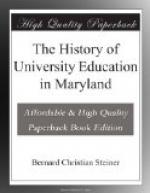On October 1, 1830, the Trustees issued a prospectus, from which we learn that it was intended “to maintain an institution on the most enlarged scale of usefulness and responsibility,” and that there was a “necessity for the proposed organization of a department in the University of Maryland, exclusively collegiate in its system, requiring an advanced state of classical and scientific attainments for admission to its lectures, calculated to conduct its pupils through the highest branches of a liberal education and to afford them advantages similar to what may be obtained in the distant Universities of this country and Europe.” A course of study equal to that of any college of the country was announced, and a brilliant Faculty appointed; but the time was not yet come for a great college in Baltimore and the institution languished away. In 1843, the Commissioners of Public Schools petitioned to have it transferred to the city as a High School, and in 1852, it had only one teacher and 36 scholars, a mere boys’ school.
In 1854 it was reorganized as the “School of Letters under the Faculty of Arts and Sciences,” with Rev. E.A. Dalrymple, formerly of the Episcopal Theological Seminary at Alexandria, as its head. On paper the course was fairly complete, and the Faculty an able one, and there were graduates in 1859, ’60, ’61, and ’63. The course was to be a three years’ one; for “the studies of Freshman year will be pursued in the preparatory department, where experience has shown they may be attended with greater advantage.” Gradually students fell off, it became a mere boys’ school, and finally Dr. Dalrymple was all that was left of the “School of Letters” and the “Faculty of the Arts and Sciences,” and at his death, both formally became extinct.
With the restoration of the property to the Regents, the classes in the medical school increased to a size somewhat like that attained in years previous to 1825, although, owing to the opening of new schools, they never quite equalled it. During the war of the Rebellion, the school suffered from the loss of southern patronage; but at its close, students came back and the school took on fresh life. It has always been in the front rank; first of all American medical schools it recognized Gynecology as a separate branch of instruction, and it was second in making practical Anatomy a compulsory study. With the session of 1891 it will require a three years’ graded course of all candidates for degrees.
In 1850 the Hon. John P. Kennedy, statesman and author, was chosen provost, and on his death in 1870, the Hon. S. Teackle Wallis was made his successor and he now fills the office with honor.
The Faculty of Law revived the Law School in the beginning of 1870, with a class of 25. An efficient faculty has caused a steady increase, until, in 1890, there were 101 students in the three years’ course. The instruction is given by lectures, examinations, and moot-courts. In 1884, the Law Department moved from its former quarters in the old Baltimore College building on Mulberry Street, to a new building erected for it on the University property on Lombard Street, next to the building of the Medical Department.




